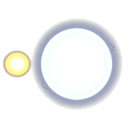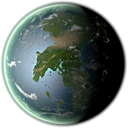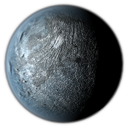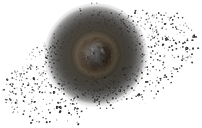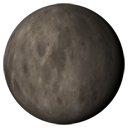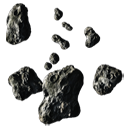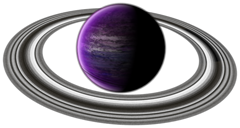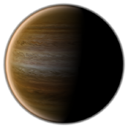Difference between revisions of "Nelnusarr"
(Star system reevaluation) |
|||
| (8 intermediate revisions by the same user not shown) | |||
| Line 1: | Line 1: | ||
{{Translate | {{Translate | ||
| ru= | | ru=Нелнусарр | ||
}} | }} | ||
Nelnusarr is a binary star in the L12 square of galactic map. This solar system is the home of [[Raharrs]], and the largest known astroengineering project of the [[Ancients]]. | |||
| Line 10: | Line 10: | ||
=== Stars === | === Stars === | ||
[[Image: Harr_Planet_star.png | frame | left]] | [[Image: Harr_Planet_star.png | frame | left]] | ||
* Orbit radius: 0. | * Orbit radius: 0.13 AU | ||
* | * Orbital period: 19 days | ||
* Radius: | * Radius: 1,115,180 km and 326,530 km | ||
* Number of satellites: 0 | * Number of satellites: 0 | ||
The stars of the system, the white star and the yellow dwarf ([https://en.wikipedia.org/wiki/Stellar_classification spectral types] | The stars of the system, the white star and the yellow dwarf ([https://en.wikipedia.org/wiki/Stellar_classification spectral types] F5.8 V and M0.9 V). Both stars are relatively close to each other, but because of the effects of stabilizers, they remain fairly stable in terms of activity. Both suns rotate around their center of mass at a distance of 0.13 AU from each other. <br> <br> <br> <br> | ||
==== Stabilizers ==== | ==== Stabilizers ==== | ||
| Line 22: | Line 22: | ||
=== Hirr === | === Hirr === | ||
[[Image: Harr_Planet_1.png | frame | left]] | [[Image: Harr_Planet_1.png | frame | left]] | ||
* Orbit radius: 0.9 | * Orbit radius: 0.9 AU | ||
* | * Orbital period: 0.34 years | ||
* Planet radius: 4,600 km | * Planet radius: 4,600 km | ||
* Number of satellites: 0 | * Number of satellites: 0 | ||
The first planet in the system. Because of | The first planet in the system. Because of its too close proximity to the suns, is like hell. The surface is constantly scorched by intense radiation, the gravitational effects of the suns' gravitational pull do not allow tectonics to subside, so that the entire planet resembles a massive ball of magma. There is nothing even remotely resembling organics on the ash-filled and lava-laden rock fields. Volcanic gas emissions give the planet a thin, diluted atmosphere. Average surface temperature varies greatly due to the ellipticity of the orbit and depends on the position of the planet relative to the stars - from +500 degrees Celsius at aphelion to +800 degrees at perihelion. Gravity - 0.8 of Earth's | ||
=== [[Harr]] === | === [[Harr]] === | ||
[[Image: Harr_Planet_2.png | frame | left]] | [[Image: Harr_Planet_2.png | frame | left]] | ||
* Orbit radius: | * Orbit radius: 1.9 AU | ||
* | * Orbital period: 1.97 years | ||
* Planet radius: 7,000 km | * Planet radius: 7,000 km | ||
* Number of satellites: 3 | * Number of satellites: 3 | ||
Home of the raharrs. The second planet of the system, it is located near the beginning of the "life zone" of the two stars. Earth-like planet, the ratio of land to water is about 30 to 70 percent. Its atmosphere is nitrogen-oxygen. Two suns, as well as a mixture of gases and peculiarities of the biosphere, give the sky on the planet a green hue, changing to orange and gold during sunrises and sunsets. The climate is mostly tropical and temperate, the subpolar region is very small and almost immediately transitions to polar. The planet has three moons. Gravity is 1.1 of Earth's. | |||
=== Hilor === | === Hilor === | ||
[[Image: Harr_Planet_3.png | frame | left]] | [[Image: Harr_Planet_3.png | frame | left]] | ||
* Orbit radius: | * Orbit radius: 2.86 AU | ||
* | * Orbital period: 3.6 years | ||
* Planet radius: 8,000 km | * Planet radius: 8,000 km | ||
* Number of satellites: 1 | * Number of satellites: 1 | ||
Hilor is the third planet of the system, located almost exactly in the center of the zone | Hilor is the third planet of the system, located almost exactly in the center of the habitat zone. However, for some reason, it is currently in a deep ice age. the temperature on its surface ranges from +5 to -60 degrees Celsius. The oceans are covered with a crust of ice, and there is almost no liquid water available on the planet's surface. Despite this, the planet has a sparse and stunted biosphere, adapted somehow to the harsh conditions, mainly clustering around active volcanoes, which emit valuable heat and melt the ice. Theoretically, more diverse life could exist beneath the ice crust on the oceans, near the seafloor. However, there have been no extensive expeditions to penetrate beneath the surface of the ice shell. Gravity - 1.5 of Earth's | ||
=== Enor === | === Enor === | ||
[[Image: Harr_Planet_4.png | frame | left]] | [[Image: Harr_Planet_4.png | frame | left]] | ||
* Orbit radius: | * Orbit radius: 4.8 AU | ||
* | * Orbital period: 8 years | ||
* Planet radius: 5,900 km | * Planet radius: 5,900 km | ||
* Number of satellites: at least 7200 (0) | * Number of satellites: at least 7200 (0) | ||
The most | The most unfortunate planet in the system. By cosmic standards, it literally only just survived a devastating collision with another celestial body, no more than a few thousand years ago. Currently, it is a small, hot planetoid with extremely inhospitable conditions for life. The "atmosphere" is a cloud of suspended dust and some gases. The surface, on which the giant impact crater is clearly visible, is constantly bombarded by debris circling the planet in abundance. As a consequence, no attempts have been made to land on this planet due to the extreme danger and difficulty of maneuvering in a cloud of planetary debris. Despite the planet not residing in the habitability zone, several times there have been sensationalist claims that asteroids containing traces of machining, or even entire preserved buildings, have been found in the debris. None of these claims has been confirmed, and some have turned out to be falsified. There are at least seven thousand large pieces of debris orbiting the planetoid at the moment, and countless pieces with diameters of tens of meters or less. All of them will return to the planet extremely quickly - within the next thousand years if not centuries. Gravity is 0.4 of Earth's. | ||
=== Raos === | === Raos === | ||
[[Image: Harr_Planet_5.png | frame | left]] | [[Image: Harr_Planet_5.png | frame | left]] | ||
* Orbit radius: | * Orbit radius: 8.74 AU | ||
* | * Orbital period: 19 years | ||
* Planet radius: 8,100 km | * Planet radius: 8,100 km | ||
* Number of satellites: 0 | * Number of satellites: 0 | ||
The fifth planet of the system is a relatively boring sight. It is a brownish planetoid almost without an atmosphere and without life, containing several unusually rich deposits of rare-earth minerals, which made planetside mining operations | The fifth planet of the system is a relatively boring sight. It is a brownish planetoid almost without an atmosphere and without life, containing several unusually rich deposits of rare-earth minerals, which made planetside mining operations viable. Despite the fact that the planet was the last to form, it cooled down very quickly as it turned out to be deprived of heavy elements, which prevented it from forming a full-fledged core and magnetosphere. Because of this, in spite of its size, it has low density and gravity is quite low on it - 0.9 Earth's. | ||
=== Asteroids === | === Asteroids === | ||
[[Image: asteroids.png | frame | left]] | [[Image: asteroids.png | frame | left]] | ||
* Orbit radius: | * Orbit radius: 10-13 AU | ||
* | * Orbital period: --- | ||
* Radius: from 20 m to 400 km | * Radius: from 20 m to 400 km | ||
An asteroid belt is located between Raos and Gaulurr, which does not represent anything extraordinary except for its density - the estimated total mass of the asteroid field could be 97% the mass of a planet | An asteroid belt is located between Raos and Gaulurr, which does not represent anything extraordinary except for its density - the estimated total mass of the asteroid field could be 97% the mass of a planet the size of Harr. <br> | ||
Perhaps the belt was formed by itself, or it is the remains of a building material left by the Ancients | Perhaps the belt was formed by itself, or it is the remains of a building material left by the Ancients. <br> | ||
Resources are being extracted in the belt, especially | Resources are being extracted in the belt, especially various rare-earth elements. <br> <br> <br> <br> | ||
=== Gaulurr === | === Gaulurr === | ||
[[Image: Harr_Planet_6.png | frame | left]] | [[Image: Harr_Planet_6.png | frame | left]] | ||
* Orbit radius: | * Orbit radius: 16.6 AU | ||
* | * Orbital period: 51.1 years | ||
* Planet radius: 106,400 km | * Planet radius: 106,400 km | ||
* Number of satellites: 143 (8) | * Number of satellites: 143 (8) | ||
The largest and most massive planet | The largest and most massive planet in the system, by many also called the most beautiful. It has the largest number of satellites - 8 planetlike moons, and more than a hundred and forty trapped asteroids and comet nuclei, which are minor satellites. Its bright violet-purple color is caused by the composition of its atmosphere. Gaulurr is an extremely active planet, which has the most furious winds - the speed can easily reach thousands of kilometers per hour or more. The only gas giant in the system with a wide and highly visible ice ring. The planet contains numerous research probes and orbital stations, and an extensive network of industrial gas extractors, processing [[hephrene]] - a highly important gas for space travel, which powers hyperspace generators and reactors, and which provides the planet with its unique purple color. The gas deposits are truly colossal, with hephrene accounting for approximately 85% of Gaulurr's mass. It is estimated that Gaulurr contains at least 70% of all Hephrene discovered in the Galaxy and that it is the only deposit where Hephrene can be detected visually. Hephrene also is speculated to be the reason for the gas giant's abnormally high mass and diameter. Planet with such mass should be much smaller and hotter, perhaps even turning into a brown dwarf, but hephrene's anomal qualities prevent this from happening, if not making it physically impossible. The humongous quantities of hephrene under such extreme conditions are a target of numerous scientific researches being conducted on the planet. This makes Nelnusarr one of the most important solar systems of the Alliance. | ||
Its bright violet-purple color is | |||
=== Hreot === | === Hreot === | ||
[[Image: Harr_Planet_7.png | frame | left]] | [[Image: Harr_Planet_7.png | frame | left]] | ||
* Orbit radius: | * Orbit radius: 32.2 AU | ||
* | * Orbital period: 138.7 years | ||
* Planet radius: 64,800 km | * Planet radius: 64,800 km | ||
* Number of satellites: 67 (5) | * Number of satellites: 67 (5) | ||
| Line 97: | Line 91: | ||
=== Harot === | === Harot === | ||
[[Image: Harr_Planet_8.png | frame | left]] | [[Image: Harr_Planet_8.png | frame | left]] | ||
* Orbit radius: | * Orbit radius: 63.6 AU | ||
* | * Orbital period: 384.1 years | ||
* Planet radius: 84,300 km | * Planet radius: 84,300 km | ||
* Number of satellites: 43 (4) | * Number of satellites: 43 (4) | ||
The most distant planet of the system and the second largest gas giant. It consists mainly of hydrogen and | The most distant planet of the system and the second-largest gas giant. It consists mainly of hydrogen, helium and methane, which gives the planet a rich blue color as a result. | ||
Harot, | |||
Harot, both with Hreot, were considered dim stars for a long time after their discovery, because of their extremely long orbital cycle. The status of the planets was confirmed only after technology had progressed enough to allow a precise triangulation of the planet's distance. | |||
{{Alliance_navigation}}{{comments|lang=en}} | {{Alliance_navigation}}{{comments|lang=en}} | ||
Latest revision as of 04:22, 2 August 2025
Nelnusarr is a binary star in the L12 square of galactic map. This solar system is the home of Raharrs, and the largest known astroengineering project of the Ancients.
System map
Stars
- Orbit radius: 0.13 AU
- Orbital period: 19 days
- Radius: 1,115,180 km and 326,530 km
- Number of satellites: 0
The stars of the system, the white star and the yellow dwarf (spectral types F5.8 V and M0.9 V). Both stars are relatively close to each other, but because of the effects of stabilizers, they remain fairly stable in terms of activity. Both suns rotate around their center of mass at a distance of 0.13 AU from each other.
Stabilizers
These objects of unknown composition are among the most massive artifacts of the Ancients, being 2568 kilometers in diameter. Apparently, their task is to control the stars of the system in order to ensure comfortable living conditions in the planetary system. They rotate at such a close distance from the stars that they are actually inside the corona, on the very border of the transition zone. In this regard, any study of these objects in the foreseeable future is not possible.
Hirr
- Orbit radius: 0.9 AU
- Orbital period: 0.34 years
- Planet radius: 4,600 km
- Number of satellites: 0
The first planet in the system. Because of its too close proximity to the suns, is like hell. The surface is constantly scorched by intense radiation, the gravitational effects of the suns' gravitational pull do not allow tectonics to subside, so that the entire planet resembles a massive ball of magma. There is nothing even remotely resembling organics on the ash-filled and lava-laden rock fields. Volcanic gas emissions give the planet a thin, diluted atmosphere. Average surface temperature varies greatly due to the ellipticity of the orbit and depends on the position of the planet relative to the stars - from +500 degrees Celsius at aphelion to +800 degrees at perihelion. Gravity - 0.8 of Earth's
Harr
- Orbit radius: 1.9 AU
- Orbital period: 1.97 years
- Planet radius: 7,000 km
- Number of satellites: 3
Home of the raharrs. The second planet of the system, it is located near the beginning of the "life zone" of the two stars. Earth-like planet, the ratio of land to water is about 30 to 70 percent. Its atmosphere is nitrogen-oxygen. Two suns, as well as a mixture of gases and peculiarities of the biosphere, give the sky on the planet a green hue, changing to orange and gold during sunrises and sunsets. The climate is mostly tropical and temperate, the subpolar region is very small and almost immediately transitions to polar. The planet has three moons. Gravity is 1.1 of Earth's.
Hilor
- Orbit radius: 2.86 AU
- Orbital period: 3.6 years
- Planet radius: 8,000 km
- Number of satellites: 1
Hilor is the third planet of the system, located almost exactly in the center of the habitat zone. However, for some reason, it is currently in a deep ice age. the temperature on its surface ranges from +5 to -60 degrees Celsius. The oceans are covered with a crust of ice, and there is almost no liquid water available on the planet's surface. Despite this, the planet has a sparse and stunted biosphere, adapted somehow to the harsh conditions, mainly clustering around active volcanoes, which emit valuable heat and melt the ice. Theoretically, more diverse life could exist beneath the ice crust on the oceans, near the seafloor. However, there have been no extensive expeditions to penetrate beneath the surface of the ice shell. Gravity - 1.5 of Earth's
Enor
- Orbit radius: 4.8 AU
- Orbital period: 8 years
- Planet radius: 5,900 km
- Number of satellites: at least 7200 (0)
The most unfortunate planet in the system. By cosmic standards, it literally only just survived a devastating collision with another celestial body, no more than a few thousand years ago. Currently, it is a small, hot planetoid with extremely inhospitable conditions for life. The "atmosphere" is a cloud of suspended dust and some gases. The surface, on which the giant impact crater is clearly visible, is constantly bombarded by debris circling the planet in abundance. As a consequence, no attempts have been made to land on this planet due to the extreme danger and difficulty of maneuvering in a cloud of planetary debris. Despite the planet not residing in the habitability zone, several times there have been sensationalist claims that asteroids containing traces of machining, or even entire preserved buildings, have been found in the debris. None of these claims has been confirmed, and some have turned out to be falsified. There are at least seven thousand large pieces of debris orbiting the planetoid at the moment, and countless pieces with diameters of tens of meters or less. All of them will return to the planet extremely quickly - within the next thousand years if not centuries. Gravity is 0.4 of Earth's.
Raos
- Orbit radius: 8.74 AU
- Orbital period: 19 years
- Planet radius: 8,100 km
- Number of satellites: 0
The fifth planet of the system is a relatively boring sight. It is a brownish planetoid almost without an atmosphere and without life, containing several unusually rich deposits of rare-earth minerals, which made planetside mining operations viable. Despite the fact that the planet was the last to form, it cooled down very quickly as it turned out to be deprived of heavy elements, which prevented it from forming a full-fledged core and magnetosphere. Because of this, in spite of its size, it has low density and gravity is quite low on it - 0.9 Earth's.
Asteroids
- Orbit radius: 10-13 AU
- Orbital period: ---
- Radius: from 20 m to 400 km
An asteroid belt is located between Raos and Gaulurr, which does not represent anything extraordinary except for its density - the estimated total mass of the asteroid field could be 97% the mass of a planet the size of Harr.
Perhaps the belt was formed by itself, or it is the remains of a building material left by the Ancients.
Resources are being extracted in the belt, especially various rare-earth elements.
Gaulurr
- Orbit radius: 16.6 AU
- Orbital period: 51.1 years
- Planet radius: 106,400 km
- Number of satellites: 143 (8)
The largest and most massive planet in the system, by many also called the most beautiful. It has the largest number of satellites - 8 planetlike moons, and more than a hundred and forty trapped asteroids and comet nuclei, which are minor satellites. Its bright violet-purple color is caused by the composition of its atmosphere. Gaulurr is an extremely active planet, which has the most furious winds - the speed can easily reach thousands of kilometers per hour or more. The only gas giant in the system with a wide and highly visible ice ring. The planet contains numerous research probes and orbital stations, and an extensive network of industrial gas extractors, processing hephrene - a highly important gas for space travel, which powers hyperspace generators and reactors, and which provides the planet with its unique purple color. The gas deposits are truly colossal, with hephrene accounting for approximately 85% of Gaulurr's mass. It is estimated that Gaulurr contains at least 70% of all Hephrene discovered in the Galaxy and that it is the only deposit where Hephrene can be detected visually. Hephrene also is speculated to be the reason for the gas giant's abnormally high mass and diameter. Planet with such mass should be much smaller and hotter, perhaps even turning into a brown dwarf, but hephrene's anomal qualities prevent this from happening, if not making it physically impossible. The humongous quantities of hephrene under such extreme conditions are a target of numerous scientific researches being conducted on the planet. This makes Nelnusarr one of the most important solar systems of the Alliance.
Hreot
- Orbit radius: 32.2 AU
- Orbital period: 138.7 years
- Planet radius: 64,800 km
- Number of satellites: 67 (5)
The smallest gas giant of the system, in size and properties most reminiscent of Jupiter.
Harot
- Orbit radius: 63.6 AU
- Orbital period: 384.1 years
- Planet radius: 84,300 km
- Number of satellites: 43 (4)
The most distant planet of the system and the second-largest gas giant. It consists mainly of hydrogen, helium and methane, which gives the planet a rich blue color as a result.
Harot, both with Hreot, were considered dim stars for a long time after their discovery, because of their extremely long orbital cycle. The status of the planets was confirmed only after technology had progressed enough to allow a precise triangulation of the planet's distance.
| Leaving the Cradle | The Cliff World | ||||||
|---|---|---|---|---|---|---|
| Species |
|  | ||||
| Organizations | Alliance | Independent Worlds | Science Corporation | Politics | |||||
| Technologies | Hephrene | Interstellar Travel | Spaceships | |||||
| Places | Planet Harr (Nelnusarr star) | "Shining" Space station | "Dawn" class spaceships | Artifact X | |||||
| Characters | Gharr | Zane | Hekaht | Ahshu | Quantum | Nea | Dan | Mark | Val | ! Virus | |||||
| Events | ! Overall chronology | |||||
| Further reading: | Civilization development stages | Instruments | Ideas | | ||||||

